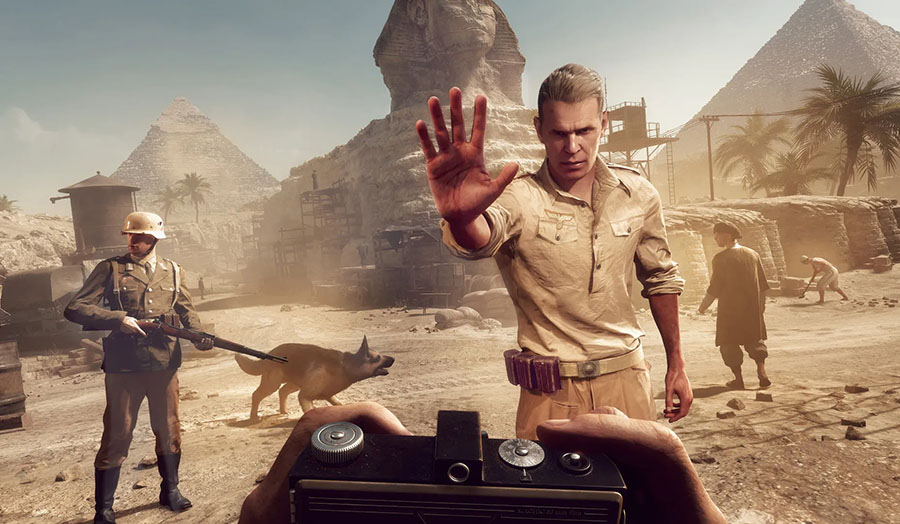The world’s greatest extreme archeologist finally got a new adventure that he and his fans deserve in the first-person video game Indiana Jones and the Great Circle (MachineGames and published by Bethesda Softworks, rated Teen, $69, reviewed on Xbox Series X|S).
That’s right, not a big-budgeted movie screwed up by Hollywood nitwits, but a story from passionate digital game producers and a team of artisans who have executed a great experience for our hero.
Taking place in 1937, and in a world on the edge of war, the story picks up after Indy has dumped his fiancée Marion and returns to his teaching job at Marshall College in Bedford, Connecticut.
An artifact stolen by a mysterious giant breaking into the school leads Indy on a journey where he will again battle the Axis powers, led by Nazi-sympathizing archeologist and rival Emmerich Voss.
His mission is ultimately to stop the bad guys from tapping into the power of the Great Circle, a formation created from a group of sacred religious sites aligned around the world.
The adventure kicks in with Indy exploring a gorgeously designed Vatican and its surroundings while avoiding an infestation of Benito Mussolini’s Blackshirts but also meeting a key ally in his quest throughout, Italian investigative reporter Gina Lombardi,
She is looking for her sister and will join him on travels from the realistic Egyptian pyramids to the Himalayan mountain range and jungles of Siam.
Indiana Jones’ vintage mannerisms seep through the action. Take a mission to explore the sewers of the Vatican that felt plucked right out for a movie. Indy walks and ducks through burial catacombs holding a torch while mist, scurrying rats, skeletons and secret passages surround his path.
At one point, Indy puts his hand in a hole to turn a handle to open a secret passage, twisting a stone near a painting of Christ’s crucifixion, and a tarantula crawls out over his arm — very unexpected, but, come on, expected. Also, a vintage Indy move has him destroying centuries-old ruins to crack open a stone tomb.
While exploring, a player can use stealth when available or close-quarter combat and firearms when being discovered and facing danger.
Indy can punch hard, block or push away in the best fisticuffs. When enemies are too tough, he can pick up an object and swing away, use his handy pistol (with limited ammo) or that famous whip to disarm or attack.
And, what could be more satisfying than sneaking up behind a Blackshirt and bashing him over the noggin with a pipe or going toe to toe with a Nazi brute landing a final blow that has him spin around and drop as Indy offers a wiseacre comment.
Indy can also carry and hide bodies and wear disguises, including a priest’s outfit and dig site worker robes and turban, to sneak around the enemy.
For sustenance, our hero can steal fruit and bread to eat and enhance health and stamina as well as use found medical bandages to restore health and repair kits to fix weapons, all packed into the limited space of his satchel.
Indy uses brawn as well as brain to collect artifacts hidden in ruins and access secret areas entered by knocking down brittle walls with any available tool or ignite small fires to burn away brush using his lighter. He can even go off of the main mission to explore open-world areas for specific field assignments.
He chronicles all of his adventures by collecting relics, hidden notes and manuscripts and often taking photos, all to earn adventure points used to increase skills.
The first really headshaking moment of the game occurs when a player gets to actually control Indiana Jones in his classic scene from “Raiders of the Lost Arc” in which he steals a golden idol from a Peruvian temple. That scene includes a boulder encounter and a fairly impressive digital character recreation of his backstabbing assistant (capturing the original actor, Alfred Molina’s likeness).
Blockbuster interactive scenes tied to brain-draining environmental puzzles are also found throughout and will unleash big smiles.
An example executed to perfection was found deep under a centuries-old fountain and in a buried and abandoned monastery courtyard.
Indy first has to climb to multiple point peaks and twist gargoyle dragons to open the face of the fountain where three puzzles using stone statues exist. He takes photos all along the way to help generate clues to solve the configurations required to access the lower area.
He is then joined by Gina to work together and move down the corridors to hidden rooms, at one point avoiding giant swinging saw blades to reach a main room containing a pair of multistory silver and gold dragons wielding shields.
Our hero must open and enter each dragon, then pass numerous fire-based trials that include aligning massive pillars using rope chains to secure a pair of keys, forged on demand.
The keys open a massive door that leads to a library filled with ancient books and then access to the Treasury of Esoteric Artifacts to retrieve a stolen cat mummy relic.
Of course, life does not get any easier as he meets in the room the giant that stole the school relic, and it’s a boss battle to knock him out before Voss shows up and now steals what was actually inside the cat mummy. Yes, vintage Indiana Jones at every twist.
The entire scene encompasses nearly everything any movie lover would want in an action film, all aligned to comfortable game mechanics, classic cinematography and perfect lighting, often with areas bathed in shadows or subdued stone interiors lit by torches carried by the heroes.
No matter a few minor quibbles with the game, some of the climbing and whip hanging in the third-person perspective can be difficult via the controller; all are immediately forgotten while watching the avalanche of iconic moments of Indy on the screen.
That includes the perfect visual representation of simply seeing the shadow of the fedora-wearing Indy with whip at his side cast on a stone wall outside the Vatican or a Giza pyramid tomb.
The character model of Indiana Jones offers an almost spitting image of Harrison Ford and especially his mannerisms down to that familiar constantly in pain, slightly bowlegged running, his swinging action when tethered to a whip or simply placing the iconic hat back on his noggin.
The vocalizations of Mr. Ford are exact, down to his pained grunts and deliberate gruff and sometimes sarcastic speech patterns, except it’s not the famed actor but a precise imitation delivered by gaming and animation voice-over veteran Troy Baker.
Equally impressive is the orchestral score from Gordy Haab that not only pays homage to John Williams’ original themes but often acts as an aural guide, foreshadowing precarious events and warning a player as danger rises.
After roughly 25 hours of action, and yet to fire a single bullet, I’ve rarely been so engrossed in a perfect blend of gameplay, visual might and intriguing narratives. Indiana Jones and the Great Circle is an exhilarating and satisfying experience not to be missed by any gamer or fan of the franchise.
Lucasfilm and Disney would be wise to let Bethesda Softworks handle the Indiana Jones legacy going forward.
Note: The game is currently only available on the PC and Xbox X|S. Expect a PlayStation 5 version this spring.





_(2)-218x150.png)































